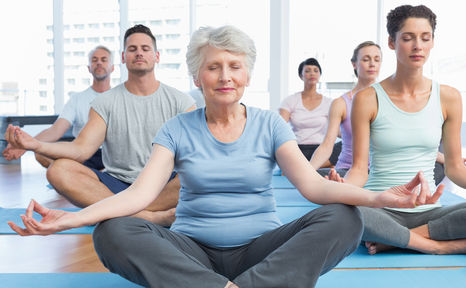

Many arthritis patients have found yoga to be helpful to both body and mind in dealing with their condition.

Yoga has grown in popularity in recent years, primarily due to its multitude of health benefits. Whether you are a beginner with mobility issues or a seasoned yoga veteran, there are a variety of poses designed to both challenge and help you.
Anyone living with arthritis knows how important exercise is for relieving your chronic joint pain. Check out the ways in which yoga may improve your pain and quality of life.
Yoga started in ancient India. According to Johns Hopkins Arthritis Center, the word "yoga" means to unite - fitting, since the time-honored practice aims to unite the body, spirit and mind. While it originally started with a more spiritual function, modern Western adaptations of the activity place more of a focus on the physical health benefits it offers.
According to the Arthritis Foundation, yoga has been shown to make living with the disease significantly easier. Practicing yoga can help decrease joint pain, improve the function and flexibility of joints and reduce muscle tension. Johns Hopkins noted that studies have also found yoga to increase energy and reduce body aches.
In addition to its potential to ease arthritis symptoms, yoga is a great way to boost mental health. The Arthritis Foundation reported that arthritis patients who incorporated yoga into their routines experienced fewer symptoms of depression, less stress and improved their ability to cope with tense situations. They also noted that yoga is connected to sleeping better, which is an essential part of staying healthy and managing pain.
"Yoga is definitely one option for people with arthritis. Not only for the exercise benefits, but it's also beneficial in the mind/body area, promoting relaxation and stress reduction," Sharon Kolasinski, MD, told The Arthritis Foundation.
The world of yoga might seem intimidating at first, but do not let this stop you from seeking out ways to bring the activity into your life. Johns Hopkins recommended first consulting your doctor to see if he or she thinks it would benefit your condition. If so, ask for advice on which areas of your body you should focus on or avoid straining. Yoga teachers are typically quick to accommodate any limitations, since most poses have simple modifications that make them accessible for just about everyone.
Johns Hopkins suggested searching for beginner classes at local studios to start. Look for places that offer Hatha yoga, as this is the type that may be most beneficial for people living with arthritis. Make sure the instructor is certified by the Yoga Alliance - this means they have undergone extensive training in not only traditional poses, but also anatomy and physiology, and are well qualified to teach. An ideal situation would be finding a yoga educator with a medical background or who specializes in helping people with chronic joint pain, but this is not a strict requirement.
Knee and Hip Exercises for Arthritis
Pilates Exercises to Ease Arthritis Pain
Flexibility Exercises Help Arthritis Patients
Copyright © www.orthopaedics.win Bone Health All Rights Reserved